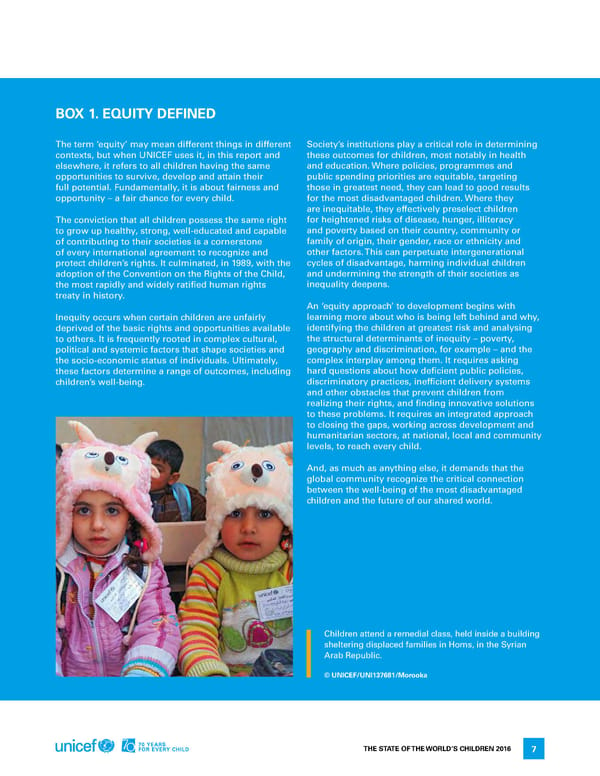BOx 1. EqUITY DEFINED The term ‘equity’ may mean different things in different Society’s institutions play a critical role in determining contexts, but when UNICEF uses it, in this report and these outcomes for children, most notably in health elsewhere, it refers to all children having the same and education. Where policies, programmes and opportunities to survive, develop and attain their public spending priorities are equitable, targeting full potential. Fundamentally, it is about fairness and those in greatest need, they can lead to good results opportunity – a fair chance for every child. for the most disadvantaged children. Where they are inequitable, they effectively preselect children The conviction that all children possess the same right for heightened risks of disease, hunger, illiteracy to grow up healthy, strong, well-educated and capable and poverty based on their country, community or of contributing to their societies is a cornerstone family of origin, their gender, race or ethnicity and of every international agreement to recognize and other factors. This can perpetuate intergenerational protect children’s rights. It culminated, in 1989, with the cycles of disadvantage, harming individual children adoption of the Convention on the Rights of the Child, and undermining the strength of their societies as the most rapidly and widely ratified human rights inequality deepens. treaty in history. An ‘equity approach’ to development begins with Inequity occurs when certain children are unfairly learning more about who is being left behind and why, deprived of the basic rights and opportunities available identifying the children at greatest risk and analysing to others. It is frequently rooted in complex cultural, the structural determinants of inequity – poverty, political and systemic factors that shape societies and geography and discrimination, for example – and the the socio-economic status of individuals. Ultimately, complex interplay among them. It requires asking these factors determine a range of outcomes, including hard questions about how deficient public policies, children’s well-being. discriminatory practices, inefficient delivery systems and other obstacles that prevent children from realizing their rights, and finding innovative solutions to these problems. It requires an integrated approach to closing the gaps, working across development and humanitarian sectors, at national, local and community levels, to reach every child. And, as much as anything else, it demands that the global community recognize the critical connection between the well-being of the most disadvantaged children and the future of our shared world. Children attend a remedial class, held inside a building sheltering displaced families in Homs, in the Syrian Arab Republic. © UNICEF/UNI137681/Morooka The STaTe of The World’S Children 2016 7
 70 Years for Every Child Page 20 Page 22
70 Years for Every Child Page 20 Page 22